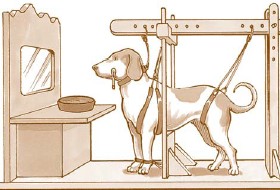Ivan Pavlov was the person who demonstrated the conditioned reflex action for the first time. And dog? here is the concept:
Reflex action is the one which the body produces in response to a sudden stimulus and the response is too quick to think of what is right or wrong. For example: sudden closing of eyes when dust approaches it OR the jerk on the hand when we come across an electric shock. A more common reflex is a KNEE JERK REFLEX ACTION.
 The reflex is of two types:
The reflex is of two types:1) Natural
2) Conditioned
Natural is the one which is inborn. Even a small child will do that. Conditioned is the one to which body gets used to with the course of time.
Examples:
1) We keep on reading the papers or books with ultimate flow. Actually, in earlier stages of learning, we learn letter by letter and then form words. With time, we gets habitual to most of words and understand the whole of the word at the instant only by judging few of its initial letters. Mostly, we never read the entire spelling of the words. That's why, sometimes we skip very small mistakes that come across us because eyes just look at some arranged words but does not care to read entire word always. This sometimes also cause us to misinterpret some words whose spelling are very similar.
2) Suppose, you are studying in a silent room. Suddenly, someone turns the fan ON. The sound of fan will disturb your concentration. But soon, you grab the attention in reading again and forget the fan's sound as if it is not their. Your ears listen to them, but your brain simply ignores those sounds from interpretation as if noise id being rectified from a TV signal by booster. It means, you soon gets used to that sound.
3) The typists make such practice that they don't even care where their fingers are going, but keep on typing the content.
4) Once you get used to your computer or mobile phone, you don't need to read the entire text of what is appearing on the screen. You mostly skip a lot of things. This is what's known as "used to", but in place of that, if you are given a new OS of computer or a new mobile with different features, you need some days to get used to it.
But where is the DOG?
Ivan Pavlov did and experiment with a DOG to prove the conditioned reflex action. He took a dog and showed him food. Simultaneously, he rang a bell. The dog gave saliva due to food. Then Pavlov gave food to dog. Next day also, he did show the food to dog and rang the bell. Dog again released saliva on seeing the food. Then the food was given. The same process was repeated for many days. After many days, once, pavlov did not bring the food, but he DID RING THE BELL. The dog again gave saliva. It was proven that for dog, the bell had formed a connection with food and whenever the bell rings, the food will be given. The dog was used to the bell's sound, not to the food's vision.
When I was in my high school, and I was studying these concepts, I did see the image of a dog in my book along with the related article of Pavlov. That dog resembled to the one on my T-Shirt. And Now, I am used to it. Whenever someone even points to my T-Shirt, I just start thinking of that page in my book unknowingly, unwillingly. I think, I have developed a conditioned reflex action within me to this T-Shirt.












